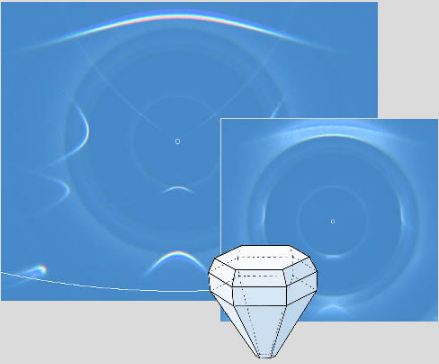Parhelia from Pyramidal Crystals
Parhelia from Pyramidal Crystals: A Mesmerizing Atmospheric Phenomenon
When it comes to atmospheric optics, one of the most captivating displays is the occurrence of parhelia, also known as sundogs. These stunning optical phenomena are typically formed by ice crystals in the atmosphere, taking on various shapes and orientations. While we are familiar with the sundogs produced by ordinary plate crystals, there is a unique variant that arises from pyramidal crystals. In this article, we will explore the mesmerizing world of parhelia from pyramidal crystals and delve into the fascinating intricacies of these exotic displays.
Unveiling the Unique Parhelia of Pyramidal Crystals
Unlike their plate crystal counterparts, pyramidal crystals can create parhelia that are strikingly different in appearance. These specialized ice crystals exhibit distinct shapes, which, when properly oriented, generate an array of peculiar parhelia. The crystal tilts play a crucial role in determining the characteristics of the resulting optical phenomena. Even with slight deviations of 1° (standard deviation), these pyramidal crystals can produce a multitude of odd parhelia, captivating viewers with their enigmatic beauty.
The Resilience of Parhelia Arcs: A Testimony to Crystal Orientation
Surprisingly, even suboptimal crystal orientations can still give rise to parhelia arcs. By increasing the crystal tilts to 15°, the display reveals a persistence of parhelia arcs, especially the exceptionally bright and colorful 23° 'upper parhelion' positioned above the sun. Despite the deviations from ideal orientation, these pyramidal crystals manage to defy expectations and continue to grace the sky with their ethereal presence.
Understanding the Naming Conventions of Pyramidal Parhelia
The term "pyramidal parhelia" originates from the circular halo ray path associated with these phenomena. However, it is important to note that the position of these parhelia in relation to the sun is not necessarily fixed at the distance of the circular halo. While the uppermost arc is referred to as a 23° parhelion, its actual location depends on the elevation of the sun. This distinction adds an extra layer of complexity and intrigue to the study of pyramidal parhelia.
Simulating the Enchanting Display: A Glimpse into the Extravaganza
To gain a deeper understanding of the mesmerizing world of pyramidal parhelia, researchers have conducted simulations to replicate these captivating displays. Using a sun-centered fisheye perspective with the sun positioned at a 30° elevation, the simulation incorporates randomly oriented crystals to generate circular halos at angles of 9°, 18°, and 23°. Through these simulations, scientists can unravel the intricate interplay between crystal orientation and the resulting optical phenomena.
Unveiling the Wonders of Atmospheric Optics: A Never-Ending Journey
The study of parhelia from pyramidal crystals is just one facet of the ever-evolving field of atmospheric optics. As researchers continue to unravel the complexities of ice crystal formation and their interaction with light, we are constantly treated to new insights and breathtaking displays in the sky. Exploring the depths of these phenomena not only captivates our imagination but also provides invaluable knowledge about the workings of our atmosphere.
Conclusion: A Glimpse into Nature's Artistry
In conclusion, parhelia from pyramidal crystals offer a glimpse into the awe-inspiring beauty and complexity of atmospheric optics. These exotic displays, born from the unique orientations of ice crystals, create a visual spectacle that leaves viewers spellbound. By delving into the intricacies of crystal tilts and their impact on parhelia arcs, we can deepen our understanding of these optical phenomena. As we continue to explore the wonders of atmospheric optics, the captivating world of pyramidal parhelia will undoubtedly continue to enchant and amaze us.

Parhelia of oriented pyramidal crystals.
When ice crystals take shapes similar to that shown they can be oriented and then produce exotic 'parhelia' very unlike the familiar sundogs of ordinary plate crystals.
The display at left has crystal tilts of 1� (std deviation) and they create many odd parhelia.
Rather poor crystal orientations can still produce parhelia arcs. The crystals in the display at right had their tilts increased to 15� at right yet some parhelion arcs survive, particularly the extremely bright and colourful 23° 'upper parhelion' above the sun.
The pyramidal parhelia are named after the equivalent circular halo ray path but, like ordinary sundogs, they are not necessarily at that distance from the sun. Thus, the uppermost arc is a 23� parhelion but it lies above the 23� circular halo and its distance depends on the solar elevation.
Simulation: sun centered fisheye with the sun 30� high. 50% of crystals were randomly oriented in order to produce the 9,18 and 23� circular halos.
Note: this article has been automatically converted from the old site and may not appear as intended. You can find the original article here.
Reference Atmospheric Optics
If you use any of the definitions, information, or data presented on Atmospheric Optics, please copy the link or reference below to properly credit us as the reference source. Thank you!
-
<a href="https://atoptics.co.uk/blog/parhelia-from-pyramidal-crystals/">Parhelia from Pyramidal Crystals</a>
-
"Parhelia from Pyramidal Crystals". Atmospheric Optics. Accessed on December 22, 2024. https://atoptics.co.uk/blog/parhelia-from-pyramidal-crystals/.
-
"Parhelia from Pyramidal Crystals". Atmospheric Optics, https://atoptics.co.uk/blog/parhelia-from-pyramidal-crystals/. Accessed 22 December, 2024
-
Parhelia from Pyramidal Crystals. Atmospheric Optics. Retrieved from https://atoptics.co.uk/blog/parhelia-from-pyramidal-crystals/.